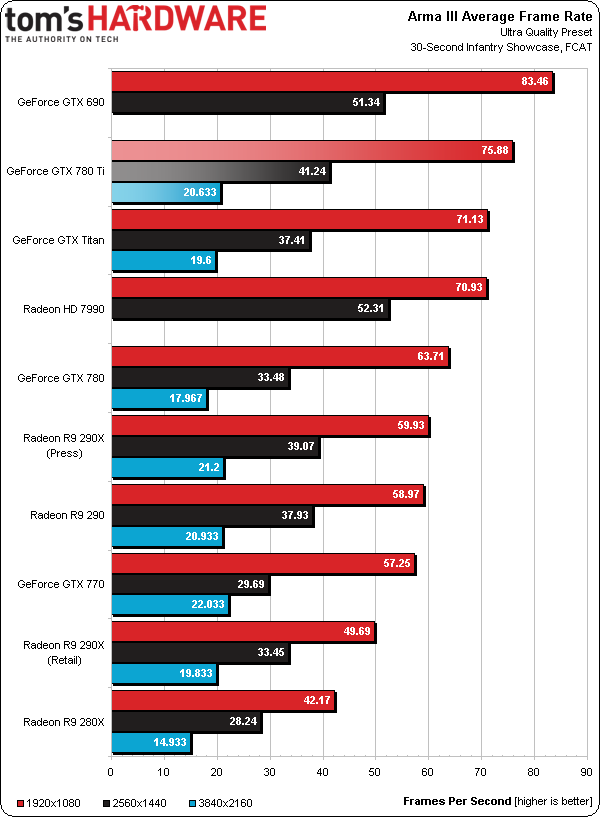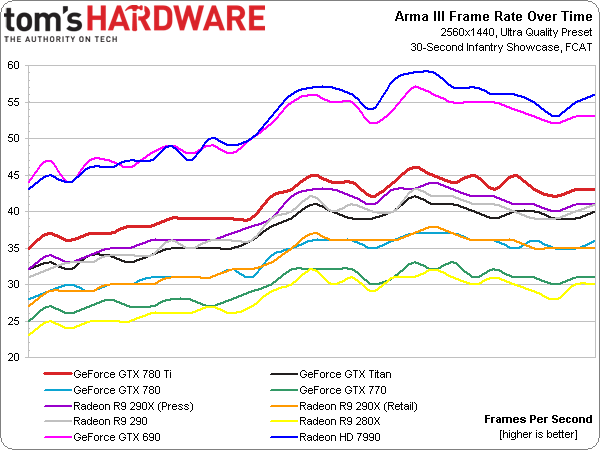Nvidia GeForce GTX 780 Ti Review: GK110, Fully Unlocked
Hot on the heels of AMD's Radeon R9 290X receiving acclaim for a fair price and high performance, Nvidia is launching its fastest single-GPU gaming card ever: GeForce GTX 780 Ti. It's quicker than 290X, but also more expensive. Is the premium worthwhile?
Results: Arma III
Average frame rates start out exceptional, as GeForce GTX 780 Ti comes close to matching Nvidia’s dual-GPU GTX 690 at 1920x1080.
Dropping to 2560x1440 hits performance pretty hard. However, you’re still looking at more than 40 FPS from GeForce GTX 780 Ti, besting Titan, 780, and 770, in that order.
The GK110-equipped 780 Ti is faster than AMD’s R9 290X. The magnitude of its victory depends on the environment you use it in. Our 290X from AMD maintains its clock rate really well in our 78-degree office, so the 780 Ti only beats it by 5%. The card we bought starts shedding frequency faster under the same conditions. GeForce GTX 780 Ti is 23% faster in that case. AMD claims that an upcoming driver will better-normalize absolute fan speeds between cards, which should facilitate more even cooling. Should that prove true, we may see these massive gaps disappear. As of this writing, however, our observations stand.
Our results become inconsistent at 3840x2160, though frame rates are too low at that resolution for a playable experience anyway.
In the two resolutions that matter most with a single-GPU graphics card, GeForce GTX 780 Ti is a standout.
Frame time variance remains wonky on the Nvidia cards at 1920x1080, and it’s pretty ugly across the board at 3840x2160. However, our numbers at 2560x1440 look much more in line with what we’d hope to see.
Get Tom's Hardware's best news and in-depth reviews, straight to your inbox.
Current page: Results: Arma III
Prev Page Test Setup And Benchmarks Next Page Results: Battlefield 4-
faster23rd My heart broke a little bit for AMD. Unless AMD's got something up their sleeve, it's up to the board manufacturers now to get the 290X in a better competitive stance than the 780 ti.Reply -
tomc100 At $700, AMD has nothing to worry about other than the minority of enthusiast who are willing to pay $200 more for the absolute fastest. Also, when games like Battlefield 4 uses mantle the performance gains will be eroded or wiped out.Reply -
expl0itfinder Keep up the competition. Performance per dollar is the name of the game, and the consumers are thriving in it right now.Reply -
alterecho I want to see cooler as efficient as the 780 ti, on the 290X, and the benchmarks be run again. Something tells me 290X will perform similar or greater than 780ti, in that situation.Reply -
ohim Price vs way too few more fps than the rival will say a lot no matter who gets the crown, but can`t wonder to imagine the look on the face of the guys who got Titans for only few months of "fps supremacy" at insane price tags :)Reply -
bjaminnyc 2x R9 290's for $100 more will destroy the 780Ti. I don't really see where this logically fits in a competitively priced environment. Nice card, silly price point.Reply -
Innocent_Bystander-1312890 "Hawaii-based boards delivering frame rates separated by double-digit percentages, the real point is that this behavior is designed into the Radeon R9 290X. "Reply
It could also come down to production variance between the chips. Seen in before in manufacturing and it's not pretty. Sounds like we're starting to hit the ceiling with these GPUs... Makes me wonder what architectural magic they'll come up with next.
IB -
bjaminnyc 2x R9 290's for $100 more will destroy the 780Ti. I don't really see where this logically fits in a competitively priced environment. Nice card, silly price point.Reply -
Deus Gladiorum I'm going to build a rig for a friend and was planning on getting him the R9 290, but after the R9 290 review I'm quite hesitant. How can we know how the retail version of that card performs? Any chance you guys could pick one up and test it out? Furthermore, how can we know Nvidia isn't pulling the same trick: i.e. giving a press card that performs way above the retail version?Reply





